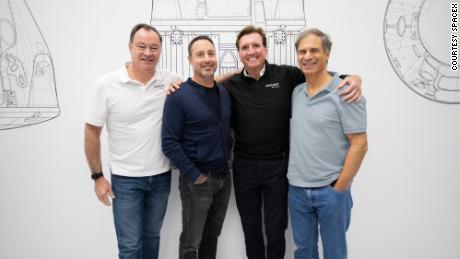The mission, called AX-1, was brokered by the Houston, Texas-based startup Axiom Space, which books rocket rides, provides all the necessary training, and coordinates flights to the ISS for anyone who can afford it. The mission has set off yet another round of debate about whether people who pay their way to space should be referred to as “astronauts,” though it should be noted a trip to the ISS requires a far larger investment of both time and money than taking a brief suborbital ride on a rocket built by companies like Blue Origin or Virgin Galactic.
The four crew members — Michael Lopez-Alegría, a former NASA astronaut turned Axiom employee who is commanding the mission; Israeli businessman Eytan Stibbe; Canadian investor Mark Pathy; and Ohio-based real estate magnate Larry Connor — are slated to leave the space station aboard their SpaceX Crew Dragon capsule on Tuesday around 10:00 pm ET.
They’ll spend the rest of the day aboard the 13-foot-wide capsule as it maneuvers back toward the edge of the Earth’s thick atmosphere. They’re slated to parachute to a splashdown landing aboard their spacecraft Wednesday afternoon, according to NASA, if weather conditions allow.
The three paying customers completed about 15 weeks of training before the flight. Though they do not have to worry about piloting their spacecraft, as the Crew Dragon is fully autonomous, they went through extensive studying of the capsule’s design, prepared for all sorts of emergency scenarios, and completed zero-gravity test flights to prepare them for space, much as professional astronauts do.
The crew arrived at the ISS about a week ago, where they were greeted by the professional astronauts already on board, including three NASA astronauts, a German astronaut and three Russian cosmonauts.
During their stay on the space station, the group stuck to a regimented schedule, which included about 14 hours per day of activities, including scientific research that was designed by various research hospitals, universities, tech companies and more. They also spent a fair amount of time doing outreach events by video conferencing with children and students.
It’s not the first time paying customers or otherwise non-astronauts have visited the ISS, as Russia has sold seats on its Soyuz spacecraft to various wealthy thrill seekers in years past. Last year, for example, a Russian actress and film crew visited the ISS to film part of a movie in an historic first.
But AX-1 is the first mission with a crew entirely comprised of private citizens with no active members of a government astronaut corps onboard during the trip to and from the ISS. It’s also the first time private citizens have traveled to the ISS on a US-made spacecraft.
It’s not clear how much this mission cost. Axiom previously disclosed a price of $55 million per seat for a 10-day trip to the ISS, but the company declined to comment on the financial terms for this specific mission beyond saying in a press conference last year that the price is in the “tens of millions.”
The mission is made possible by very close coordination among Axiom, SpaceX and NASA, since the ISS is government-funded and operated.
The space agency has revealed some details on how much it’ll charge for use of its 20-year-old orbiting laboratory.
Food alone costs $2,000 per day, per person, in space. Getting provisions to and from the space station for a commercial crew is another $88,000 to $164,000 per person, per day. For each mission, bringing on the necessary support from NASA astronauts will cost commercial customers another $5.2 million, and all the mission support and planning that NASA lends is another $4.8 million.


